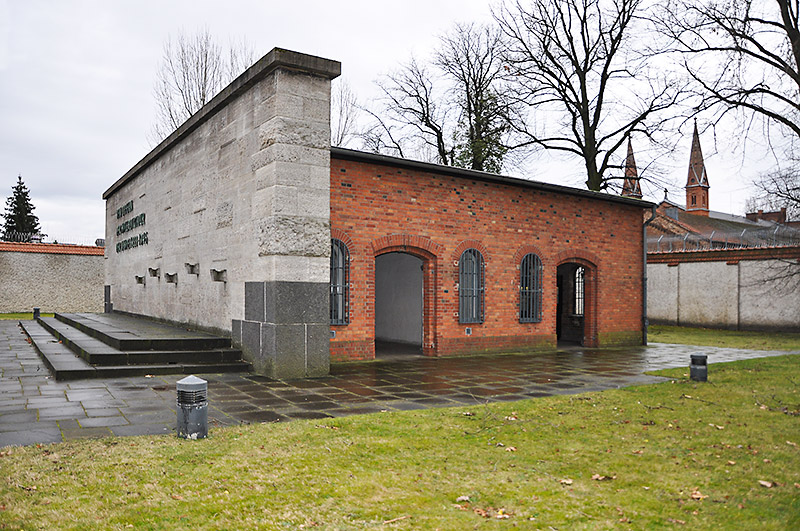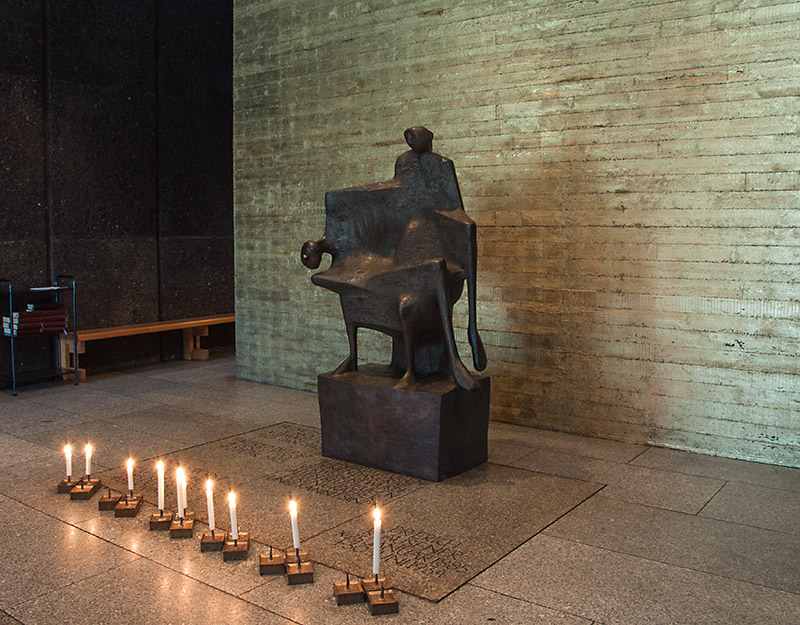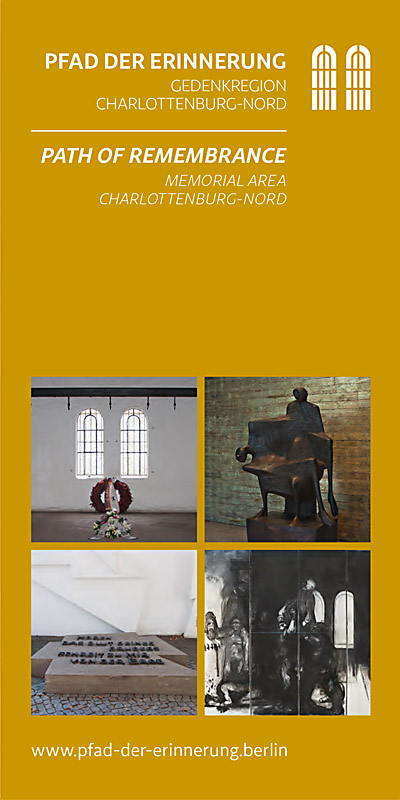Since the early 1950s, almost all streets, squares and public buildings in the memorial area Charlottenburg-Nord have been named after men and women who resisted National Socialism for various reasons. Many of them were executed at Plötzensee prison.
The biographies of the people in resistance were researched and written in it’s majority by Gedenkstätte Deutscher Widerstand (“German Resistance Memorial Center”) and provided together with the photos as part of a cooperation with Bezirksamt Charlottenburg-Wilmersdorf for the website “Path of Remembrance”. They are part of a comprehensive collection to be find at https://www.gdw-berlin.de/en/recess/biographies/index_of_persons/.

Peter Buchholz
January 31, 1888 – May 4, 1963
Peter Buchholz was born in 1888 into the large family of a cabinet-maker in the village of Eisbach, near Bonn. Following a theological education, he was ordained a Catholic priest in 1911. During the First World War, he was division chaplain from 1915 and served directly on the frontline. From 1918, Buchholz first spent many years working as a chaplain in Essen before he became a prison chaplain in 1926. In May 1943, he was transferred to Berlin, where his responsibilities as a Catholic priest also included attending to inmates of the prison at Berlin-Plötzensee, where one of the central National Socialist execution sites was located. At this point in time, more than a hundred death sentences handed down by the National Socialist judiciary were being carried out every month. Buchholz ministered to those German and foreign prisoners who had resisted the National Socialist regime and were awaiting execution. From August 1944, these mainly consisted of people who were arrested as a result of their involvement in the attempted coup of 20 July and murdered in Plötzensee. In close cooperation with the protestant priest Harald Pölchau, he passed on final messages to or from relatives of the prisoners or secretly delivered food or letters. After the war, he was briefly made commissioner for church affairs in the newly formed municipal authorities of Berlin, before he returned to the Rhineland in 1946. In addition to resuming his work as a prison chaplain, he also gave numerous lectures and radio interviews in which he called for the commemoration of the men and women of the resistance who were executed in Plötzensee. Peter Buchholz died at the age of 75 on May 4, 1963, in Bonn.
Berliner Forum für Geschichte und Gegenwart e.V.
Photo: Stiftung Eisbacher Marienkapelle

Gustav Dahrendorf
February 08, 1901 – October 30, 1954
Businessman Gustav Dahrendorf was elected to the Reichstag for the Social Democrats in 1932 and was one of the youngest representatives. He was taken into custody as a Social Democrat twice in 1933. Dahrendorf used his job as a fuel wholesaler to maintain illegal connections with former members around Julius Leber, Carlo Mierendorff, Theodor Haubach, and Wilhelm Leuschner. He was married to Lina Maria Sörnsen, with whom he had two sons. He worked with the groups around Ludwig Beck and Carl Goerdeler, participating in their planning for a coup. Gustav Dahrendorf volunteered to act as political commissioner for Military District X (Hamburg). Following the unsuccessful attempt on Hitler’s life, the People’s Court under Roland Freisler sentenced the Social Democrats Julius Leber, Adolf Reichwein, and Hermann Maass to death on October 20, 1944. In the same trial, Gustav Dahrendorf was sentenced to seven years in a penitentiary. He remained a prisoner in the Brandenburg-Görden penitentiary until he was liberated by Soviet troops. After the war, he opposed the forced merger of the Social Democratic Party and Communist Party in the Soviet occupation zone to form the East German Communist Party (SED). Forced to flee, he later took on a new responsibility in Hamburg, where he played an active part in establishing consumer cooperatives.
The German Resistance Memorial Center – www.gdw-berlin.de/en/home/
Photo: Institut für Zeitgeschichte, München Signatur: Ed. 106 Bd. 28
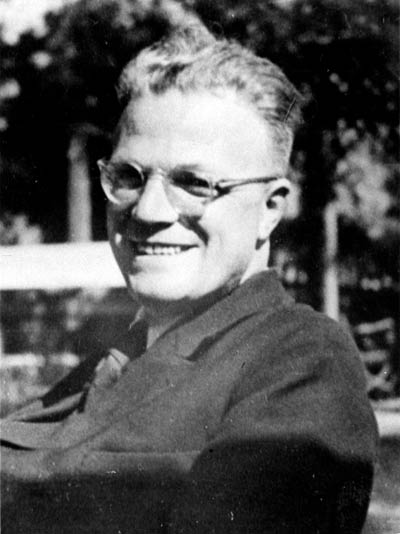
Alfred Delp
September 15, 1907 – February 02, 1945
Born in Mannheim as the oldest of six children to Catholic and Protestant parents, Delp decided in favor of Catholicism at the age of fourteen. The youth movement decisively influenced his inner development. His decision to become a Jesuit sprang from his desire to break out of bourgeois conventions and to consciously devote himself to serving his neighbors. After studying philosophy and theology, Delp served as a youth worker and was ordained as a priest in 1937. He was the editor of the renowned Catholic periodical Stimmen der Zeit until it was prohibited in 1941. After this, he devoted his energy exclusively to his duties as a parish priest in Munich. Augustin Rösch initiated him into the Kreisau Circle, and in 1942 to 1943 he was an avid participant, helping to ensure that basic premises of Catholic ethical teachings were incorporated into the plans for a new order. He attended the second and third Kreisau conferences and presented essays on the issue of the workers and on the farmers. However, he was more than merely a thinker and philosopher, and also established contacts between individual Munich resistance circles and the group around Moltke. On July 28, 1944, Delp was arrested in Munich. He was sentenced to death by the People’s Court on January 11, 1945, and murdered on February 2, 1945, in Berlin-Plötzensee.
The German Resistance Memorial Center – www.gdw-berlin.de/en/home/
Photo: Private

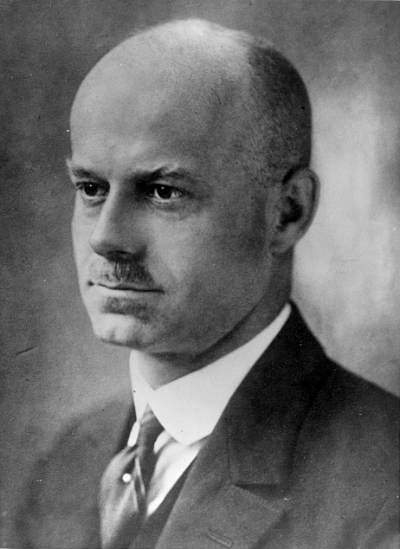
Elisabeth and Erich Gloeden
December 9, 1903 – November 30, 1944 / August 23, 1888 – November 30, 1944
Erich Gloeden was the son of the distinguished Jewish bronze foundry owner, Siegfried Loevy. The workshop of the Loevy brothers produced, for example, the inscription “Dem deutschen Volke” on the Reichstag building in Berlin. Born Erich Loevy, he had himself adopted in 1918 by a friend of the family to dispose of his Jewish name. During the war, he worked as an architect in Berlin.
Elisabeth “Lilo” was born in Cologne and was a doctor of law and judicial trainee. She and Erich Gloeden married in 1938. The couple, along with Lilo’s mother, Elisabeth Kuznitzky, who lived with them, helped persecuted Jews. She mainly supplied food to friends and relatives who had gone underground.
In late July 1944, they allowed the general of the artillery, Fritz Lindemann, to go into hiding in their apartment. He was one of the leaders of the failed assassination and coup attempt of July 20 and had first gone underground in Dresden. The general’s location was betrayed through a denunciation: on September 3 the Gestapo stormed the apartment. Fritz Lindemann was seriously wounded during the raid. Elisabeth and Erich Gloeden, along with Elisabeth Kuznitzky and other helpers, were arrested and badly beaten. Fritz Lindemann was taken to a police hospital, where he died on September 22,1944. Elisabeth Gloeden, Erich Gloeden and Elisabeth Kuznitzky were sentenced to death by the Volksgerichtshof (People’s Court) on November 27 and executed in Plötzensee prison three days later, on November 30, 1944.
Berliner Forum für Geschichte und Gegenwart e.V.
Photo: private, German Resistance Memorial Center

Carl Friedrich Goerdeler
July 31, 1884 – February 02, 1945
Carl Friedrich Goerdeler had been mayor of Leipzig since 1930, and in the final phase of the Weimar Republic he also served as Reich commissar for price regulation. He was married to Anneliese Ulrich, with whom he had two daughters and three sons. He remained in office as mayor after the National Socialist takeover, and in 1934–35 he again assumed responsibility for price regulation, becoming a vocal critic of rearmament. From 1935 on, Goerdeler had a series of vehement disputes with the NSDAP. After resigning as mayor in April 1937, Goerdeler worked as a consultant for the Bosch corporation and traveled extensively throughout Germany and abroad. In doing so, he attempted to win support for the oppositional goals of his anti-National Socialist policies. From 1938 on, Goerdeler became the focus of the civilian resistance circles. Goerdeler was designated to become chancellor following the successful assassination of Hitler. Goerdeler initially criticized specific manifestations of Hitler’s armaments and economic policy in numerous memoranda during the late 1930s, warning that the consequences of these policies would necessarily lead to war. Primarily for the benefit of his political friends, he later drafted position papers for discussion regarding basic issues of the reorganization of political life in Germany following a successful coup. Some of these papers were the subject of heated controversy. He proposed a renewal of political life based on extensive political autonomy, albeit autonomy defined by social class. Goerdeler was wanted by the Gestapo even before July 20, 1944, and was forced to go underground. He initially succeeded in avoiding arrest after the attempted coup but within a short time was reported to the authorities. On September 8, 1944, he was sentenced to death by the People’s Court under Roland Freisler. On Hitler’s orders, he was only murdered in Berlin-Plötzensee five months later on February 2, 1945, after undergoing exhaustive interrogations and preparing written statements describing the proposed new order.
The German Resistance Memorial Center – www.gdw-berlin.de/en/home/
Photo: German Resistance Memorial Center

Nikolaus Gross
September 30, 1898 – January 23, 1945
Nikolaus Gross grew up in the Ruhr valley in a blacksmith’s family. After leaving elementary school, his first job was in a steel mill. From 1915 on, he worked in a mine. In 1917 he joined the Gewerksverein christlicher Bergarbeiter (Trade Organization of Christian Miners) and served as labor union secretary in Oberhausen, Silesia, and Saxony before returning to Bottrop in 1924. From 1926 on, he belonged to the close circle of associates of Otto Müller, president of the Verband Katholischer Arbeiter- und Knappenvereine Westdeutschlands (Association of Catholic Workers’ and Miners’ Organizations of Western Germany). In 1927 Gross became editor of the newspaper Westdeutsche Arbeiterzeitung and worked in close cooperation with Bernhard Letterhaus. Both of them were openly critical of the National Socialists even before 1933. When the Westdeutsche Arbeiterzeitung was banned in 1938, Gross published its successor, the periodical Ketteler-Wacht. From 1941 on, he provided spiritual guidance for men and sought to use this channel to continue the work of the association. Gross was repeatedly arrested and interrogated. His association with Carl Goerdeler and Jakob Kaiser came to light after July 20, 1944. On August 12, 1944, he was arrested, and he was sentenced to death by the People’s Court on January 15, 1945. Against all regulations, his wife Elisabeth was allowed to see him one last time in Berlin’s Tegel prison. Nikolaus Gross was murdered a short time later in Berlin-Plötzensee.
The German Resistance Memorial Center – www.gdw-berlin.de/en/home/
Photo: Katholische Arbeitnehmerbewegung Deutschland, Diözesanverband Köln
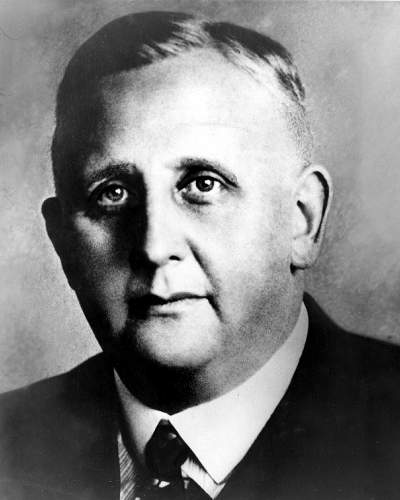
Max Habermann
March 21, 1885 – October 30, 1944
Max Habermann was a leading member of the German National Shop Assistants’ Federation until 1933. After the labor unions were smashed by the National Socialists, who placed Habermann under house arrest for a period, he opened a shop for office supplies in 1934. He was married to Anni Stoffers, with whom he had two daughters and five sons. From the winter of 1934–35 on, he was in contact with Jakob Kaiser and formed increasingly close links with him and Wilhelm Leuschner. From the beginning of the war on, Max Habermann joined Kaiser and Leuschner in planning a unified labor union to be established after the fall of the National Socialist regime. After the failure of the coup attempt of July 20, 1944, Habermann was able to hide with friends in Bielefeld. When his refuge was destroyed by a bomb attack he decided to take shelter with his wife and was arrested by the Gestapo. The next day he committed suicide in Gifhorn Court Prison.
The German Resistance Memorial Center – www.gdw-berlin.de/en/home/
Photo: AdsD/Friedrich-Ebert-Stiftung Signatur: 6/FOTA054809
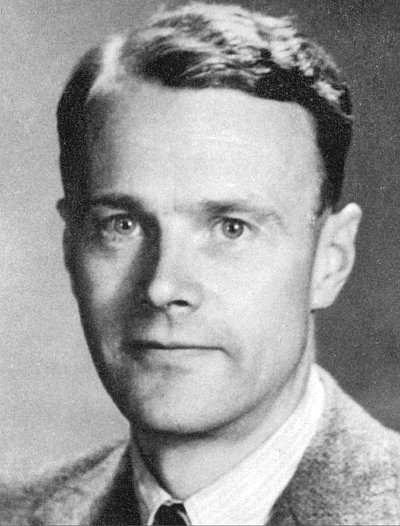
Hans Bernd von Haeften
December 18, 1905 – August 15, 1944
Hans Bernd von Haeften was born as the second child in the family of a respected officer. His father later became president of the Reich Archives. Hans Bernd von Haeften, his elder sister and his brother Werner, who was three years younger, grew up in a liberal conservative atmosphere at home, where well-known scholars were regular visitors. Some of the people the Haeften brothers met when they were young later became their comrades in the resistance. Hans Bernd von Haeften began studying legal science in Berlin and Munich in 1924. After his final law examination in 1928 he spent a year in England as an exchange student. From 1930 to 1933 he was managing director of the Stresemann Foundation. At that time he established initial contacts with the ecumenical movement of the European Churches. In 1933 he joined the Foreign Service; even as a diplomat he consistently refused to join the National Socialist Party (NSDAP). Haeften was one of the most important confidants in the Foreign Office for the conspirators around Claus Schenk Graf von Stauffenberg. A close friend of Adam von Trott zu Solz, Haeften was also a member of the Kreisau Circle and was designated as an undersecretary of state in the Foreign Office in the event of a successful coup against Hitler. After the failure of the coup attempt of July 20, 1944, Hans Bernd von Haeften was able to get away from Berlin, but returned to the city on July 22. The Gestapo arrested him the next day. He was sentenced to death by the People’s Court on August 15, 1944 and murdered only hours later in Berlin-Plötzensee.
The German Resistance Memorial Center – www.gdw-berlin.de/en/home/
Photo: Private
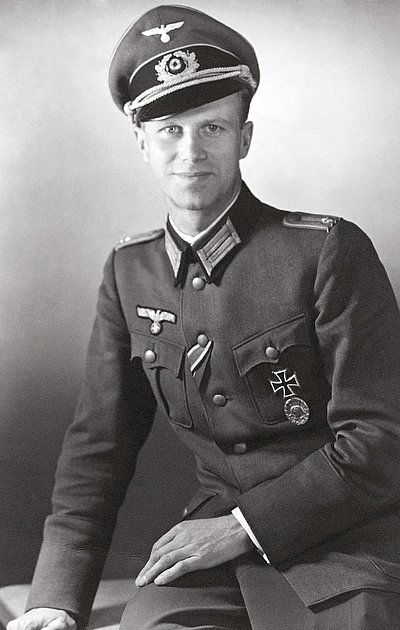
Werner von Haeften
09. October 1908 – 20. July 1944
An attorney and first lieutenant, Haeften serves primarily on the eastern front. After recovering from being severely wounded, he is assigned to the staff of commanding officer of the Ersatzheer (Reserve Army) and serves as Stauffenberg’s adjutant from November 1943 on. There he plays a key role in planning the assassination attempt. On July 20, 1944, Haeften and Stauffenberg fly to Hitler’s headquarters in the “Wolf’s Lair” near Rastenburg in East Prussia. Here Haeften helps Stauffenberg with the final preparations for the assassination attempt. After the bomb detonates, Haeften and Stauffenberg are able to leave the restricted area surrounding Hitler’s headquarters under a pretext, and they succeed in escaping to Berlin by air. After the attempted coup has failed, Haeften is executed by a firing squad in the inner courtyard of the Bendler Block in the night of July 20-21, 1944, together with Stauffenberg, Friedrich Olbricht, and Albrecht Ritter Mertz von Quirnheim.
The German Resistance Memorial Center – www.gdw-berlin.de/en/home/
Photo: Privatbesitz

Nikolaus Christoph von Halem
March 15, 1905 – October 9, 1944
Nikolaus Christoph von Halem began studying law in Heidelberg in 1922. There, he became a member of the “akademischer Corps” student league, where he first met subsequent resistance fighters. In 1931, he married Victoria Maria Grabe; the couple had two sons. In the summer of 1933, he resigned from his judicial training because he did not want to swear the oath of allegiance to Hitler and took up work as a freelance economic consultant. He made contact with other dissidents, such as Karl Ludwig Freiherr von und zu Guttenberg, Henning von Tresckow and Herbert Mumm von Schwarzenstein. In 1939, he met the communist resistance fighter Joseph Römer and together, they started plotting to assassinate Hitler. Römer was arrested and tortured and is thought to have revealed the names of his co-conspirators, von Halem and von Schwarzenstein.
In February 1942, von Halem was arrested. Although he was severely tortured in a total of ten prisons and concentration camps, he did not divulge the names of any fellow resistance activists. On June 16,1944, the Volksgerichtshof (People’s Court) sentenced von Halem and von Schwarzenstein to death. Von Halem was executed on October 09, 1944, in Brandenburg prison.
Berliner Forum für Geschichte und Gegenwart e.V.
Photo: private

Ernst Heilmann
April 13, 1881 – April 03, 1940
Ernst Heilmann came from a Jewish family and joined the SPD at the early age of 17. He studied law and political science but first worked as a journalist and parliament reporter. In the First World War, he was badly wounded in action at the frontline. In 1919, he married Magdalena Müller, with whom he had four children. He resumed his activities as a writer and campaigned on behalf of war veterans. However, he devoted most of his time to the SPD: First, as parliamentary party leader in the Landtag of Prussia, and then from 1928 to 1933 as a member of the Reichstag. He wrote numerous articles well in advance against the National Socialists and their plans. Shortly after the SPD was banned, Heilman was arrested by the Gestapo in June 1933. It was the beginning of seven years of abuse, humiliation and torture in various prisons and concentration camps. On April 03, 1940, he was murdered in Buchenwald Concentration Camp.
Berliner Forum für Geschichte und Gegenwart e.V.
Photo: Gedenkstätte Deutscher Widerstand

Paul Hertz
June 23, 1888 – October 23, 1961
Paul Hertz was born in 1888 in Worms and came from a Jewish family. In 1903, he began training as a merchant and became active in a trade union. In 1908, he formally abandoned the Jewish faith. From 1910, he began studying national economics at Munich University, which accepted him despite his failure to complete his school education, and completed his studies with a doctorate in 1914. In 1917, he joined the Unabhängige Sozialdemokratische Partei (USPD – “Independent Socialist Party of Germany”) and became business editor of the party newspaper “Freiheit” (Freedom). He began his political career in 1920 in Berlin, where he became councillor for nutrition, finance and taxation in the district of Charlottenburg. A short time later, the Weimar Republic’s first elections to the Reichstag were held. Paul Hertz was elected a member of parliament on behalf of the USPD. After the right wing of the party re-joined the SPD, he represented the SPD in parliament from 1922.
Shortly after the National Socialists seized power, he travelled in his capacity as SPD politician to Denmark and Sweden to inform fellow Social Democrats there about the situation in Germany. On his return, he was able to avoid arrest thanks to a tip-off and fled to Prague via Zurich. He continued to remain active in the SPD while there, working for the exiles’ newspaper “Die sozialistische Aktion” (The Socialist Action) and served on the advisory board of the League of Nations. In 1938, Hertz and his family fled to Paris. A year later, they emigrated to the US.
In 1949, at the request of the mayor, Ernst Reuter, Hertz returned to Berlin. In part because of the expertise and contacts he had acquired in the US, he was made Senator for the Marshall Plan and Banking, with responsibility for the emergency programme in Berlin. Later, he became Senator for Economics and Finance, which included responsibility for residential construction in the city. His work represented a major contribution to rebuilding efforts in post-war Berlin. Paul Hertz died on October 23, 1961, in Berlin.
Berliner Forum für Geschichte und Gegenwart e.V.
Photo: German Resistance Memorial Center
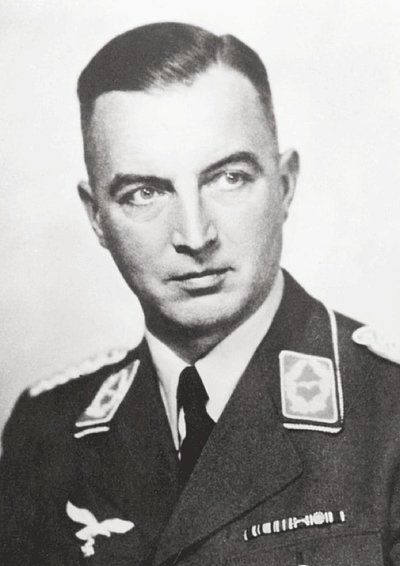
Cäsar von Hofacker
March 11, 1896 – December 20, 1944
Returning to Germany after being held by French forces as a prisoner of war in Greece, Cäsar von Hofacker began law school in 1920. From 1927 on, he worked for Vereinigte Stahlwerke in Berlin, where in 1938 he was a senior manager with general commercial power of attorney. In 1931 he joined the Stahlhelm (Steel Helmet), the federation of combat veterans. He was married to Ilse Pastor, with whom he had five children. A reserve officer, he was recalled to active duty in the Wehrmacht in 1939. Following the occupation of France in 1940, he served with the German military administration in Paris and later joined the staff of the military commander in France, General Carl-Heinrich von Stülpnagel, in the fall of 1943. Hofacker was Stauffenberg’s cousin and acted as a liaison between the military opposition in Paris and Berlin. He also had contacts with the French resistance and with the Freies Deutschland (Free Germany) movement there. On July 20, 1944, Hofacker and Stülpnagel were responsible for the short-lived but very successful coup attempt in France. After the conspiracy failed, Cäsar von Hofacker was arrested in Paris on July 26, 1944. He was sentenced to death by the People’s Court on August 30, 1944, and murdered on December 20, 1944, in Berlin-Plötzensee.
The German Resistance Memorial Center – www.gdw-berlin.de/en/home/
Photo: Gedenkstätte Deutscher Widerstand
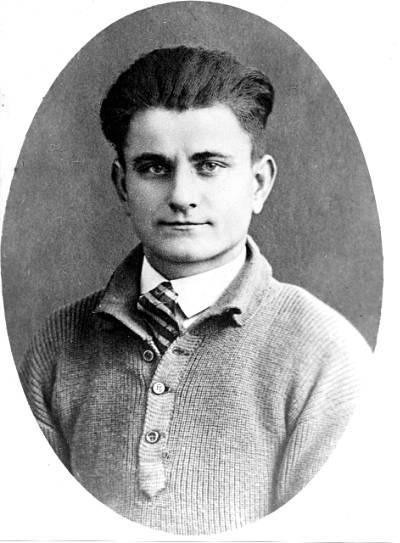
Richard Hüttig
March 18, 1908 – June 14, 1934
Richard Hüttig was from Bottendorf in Thüringen and moved to Berlin in his youth. He worked as a brick-layer, lived in a working-class neighbourhood of Charlottenburg and joined the Rote Jungfront (Red Youth Front) of the German Communist Party, the KPD. From 1930, he led the Häuserschutzstaffel (House Protection Squadron) of the newly founded “Kampfbund gegen den Faschismus” (Combat Alliance against Fascism) in his neighbourhood, “Kleiner Wedding”. The aim was to protect the houses and their residents from attack by SA Stormtroopers. In the early months of 1933, there were numerous street battles between SA members and the communists of the Combat Alliance, during one of which, on February 17, 1933, the SS Scharführer (Squadron Leader) von der Ahé was shot dead.
On the advice of friends, Hüttig left Berlin for a short while. In June 1933, he returned and tried to re-organize the House Protection Squadron, which had been decimated by arrests. He and other members were arrested in a raid in September and taken to the Gestapo prison Columbiadamm – later to become Columbiahaus Concentration Camp – and badly beaten. With the declared intention of having a deterrent effect on resistance activities by means of a death sentence against the main defendant Hüttig, he and 16 other men were put on trial on February 1, 1934. Although the court acknowledged in its verdict that there was no evidence against Hüttig, he was sentenced to death for “severe breach of the peace and attempted murder”. The other members of the Charlottenburg House Protection Squadron received lengthy prison sentences. On June 14, 1934, Richard Hüttig was executed in Plötzensee Prison. He was the first political prisoner to be put to death there.
Berliner Forum für Geschichte und Gegenwart e.V.
Photo: Bezirksamt Charlottenburg

Jakob Kaiser
February 08, 1888 – May 07, 1961
Jakob Kaiser initially learned the bookbinder’s trade and was active in the Kolping-Verein in Nürnberg even before the First World War. In the Weimar Republic, he was regarded as a leading proponent of the Christian labor union movement. He soon became a resolute opponent of the National Socialists, who in 1933 forced all the individual unions to conform to the party line and form the “German Labor Front.” From the beginning of the National Socialist regime, Kaiser remained in close contact with Wilhelm Leuschner and Max Habermann. With them, Kaiser spoke out in support of a single amalgamated labor union. A circle of opponents of the regime in close contact with Carl Goerdeler formed around Kaiser in the years that follow. After the unsuccessful assassination attempt of July 20, 1944, Kaiser was wanted by the Gestapo. However, with the aid of his later wife and long-time political associate Elfriede Nebgen, he was able to go underground. Kaiser survived the end of the war and went on to become one of the founding members of the Christian Democratic Party in Berlin.
The German Resistance Memorial Center – www.gdw-berlin.de/en/home/
Photo: Institut für Zeitgeschichte, München, Signatur: ED 106/33

Johanna Kirchner
April 24, 1889 – June 09, 1944
Johanna Kirchner came from a long-standing social democratic family in Frankfurt am Main. At the age of 14 she belonged to the Young Socialist Workers (SAJ). Later she joined the Social Democratic Party (SPD) and worked for the Workers’ Welfare Organization and as a newspaper correspondent at party and labor union congresses. In 1933 an arrest warrant was issued for her while she was on a trip to Switzerland to organize escape assistance for other victims of persecution by the National Socialist regime. She emigrated initially to the Saar region and participated in the preparations for the Saar Referendum but had to flee again in January 1935. She went to Forbach in France near the German border, where she remained closely involved in the struggle of Hitler’s German opponents, and had contact with communist groups. Working at the Advisory Office for Saar Refugees, from 1936 on she published an information journal with Emil Kirschmann. In 1937 she became a member of the Relief Committee for the Saar-Palatinate Region established in Strasbourg. After the beginning of the Second World War, Johanna Kirchner was interned by order of the French government. She was liberated from Gurs camp with the help of French friends, but the Vichy government later extradited her to Germany. From June 9, 1942 on she was subjected to Gestapo interrogation in Germany. In May 1943 the People’s Court sentenced her to 10 years in a penitentiary. In a retrial, Johanna Kirchner was sentenced to death by the People’s Court on April 21, 1944 and murdered on June 9, 1944 in Berlin-Plötzensee.
The German Resistance Memorial Center – www.gdw-berlin.de/en/home/
Photo: AdsD/Friedrich-Ebert-Stiftung, Signatur: 6/FOTA007180
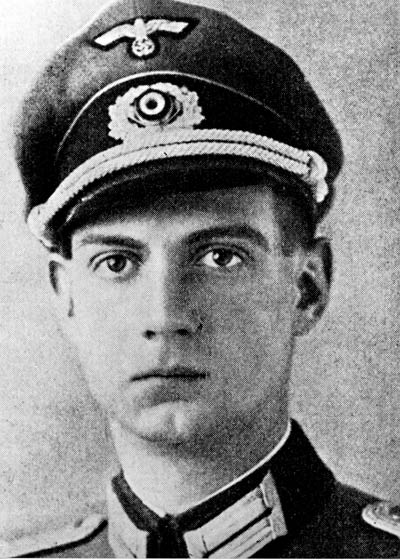
Friedrich Karl Klausing
May 24, 1920 – August 08, 1944
Friedrich Karl Klausing aspired to become a career officer and joined the distinguished 9th Infantry Regiment in Potsdam as a cadet in 1938. After the Second World War began, he first served in Poland and France and then took part in the fighting near Stalingrad in 1942–43, where he was seriously wounded. After being wounded a second time in 1943, he was transferred to Berlin for domestic service with the Armed Forces High Command. Fritz-Dietlof Graf von der Schulenburg succeeded in winning him over for the conspiracy against Hitler. On July 15, 1944, Klausing accompanied Claus von Stauffenberg to Hitler’s headquarters in East Prussia, the “Wolf’s Lair,” as Stauffenberg’s adjutant. On July 20, 1944, Klausing was present in the Bendler Block, the conspirators’ command center, where he shared responsibility for relaying the “Valkyrie” orders. In the night of July 20-21, 1944, he initially succeeded in escaping and hiding with friends. However, he surrendered to the Gestapo the next morning. Friedrich Karl Klausing was sentenced to death by the People’s Court in the first show trial of the conspirators on August 8, 1944, and murdered the same day in Berlin-Plötzensee.
The German Resistance Memorial Center – www.gdw-berlin.de/en/home/
Photo: Bundesarchiv, Signatur: Bild 146II-760

Bernhard Letterhaus
July 10, 1894 – November 14, 1944
Bernhard Letterhaus grew up in Barmen and after serving an apprenticeship in a textile factory attended advanced technical school for textile design. He became active in the Catholic labor movement at an early age. After serving in the First World War, he was active in the Central Association of Christian Textile Workers. In 1927, he assumed the position of secretary in the central office of the Catholic Labor Movement in Mönchengladbach at the request of Otto Müller, chief executive officer of the Verband Katholischer Arbeiter- und Knappenvereine Westdeutschlands (Association of Catholic Workers’ and Miners’ Organizations of Western Germany). In 1928, the association’s board of directors moved to the Ketteler-Haus in Cologne. This brought Letterhaus into constant contact with Nikolaus Gross. Letterhaus, who had a daughter with his wife Grete Thiel, represented the Center Party in the Prussian parliament. Because he opposed the Prussian Enabling Act, he boycotted the vote on the bill in the Prussian parliament in March 1933. Letterhaus also criticized the Concordat because he believed it would not offer sufficient protection to the institutions of political Catholicism. In spite of this, he was successful in keeping his own association alive until 1938. After the war began, Letterhaus was drafted into military service, and in 1942 he was transferred to Armed Forces High Command in Berlin. Here he established contact with the conspirators around Ludwig Beck and Carl Goerdeler. At the same time, he made his home in Cologne available to political friends such as Jakob Kaiser, Alfred Delp, Nikolaus Gross, and Heinrich Körner for discussions about a new order in Germany. Letterhaus was willing to assume the office of political representative for military district VI (Münster) in the event of a successful coup. A few days after the unsuccessful assassination attempt of July 20, 1944, Bernhard Letterhaus was arrested. He was sentenced to death by the People’s Court on November 13, 1944, and murdered one day later in Berlin-Plötzensee.
The German Resistance Memorial Center – www.gdw-berlin.de/en/home/
Photo: Katholische Arbeitnehmerbewegung Deutschland, Diözesanverband Köln

Franz Leuninger
December 28, 1898 – March 01, 1945
Franz Leuninger learned the trade of bricklayer and later headed various district organizations of the Christian labor unions in the Weimar Republic. He was married to Anna Paulina Meuser, with whom he had three sons. He became a member of Breslau city parliament for the Center Party in 1930, and stood as a candidate in the Reichstag elections in March 1933. Leuninger was a resolute opponent of National Socialism. After the labor unions were smashed in the early summer of 1933, he became managing director of the cooperative housing association “Deutsches Heim”. This enabled him to maintain links with persecuted persons and opponents of the Nazi regime. Later he came in contact with the resistance groups around Carl Goerdeler and Ludwig Beck. The conspirators persuaded Leuninger to take the post of regional commissioner of the province of Silesia in the event of a successful coup. After the assassination attempt of July 20, 1944, he was arrested on September 26, 1944 and held in Lehrter Straße Prison in Berlin for several months. He was sentenced to death by the People’s Court on February 26, 1945 and murdered on March 1, 1945 in Berlin-Plötzensee.
Die Biografie wurde von der Gedenkstätte Deutscher Widerstand erarbeitet und im Rahmen einer Kooperation mit dem Bezirksamt Charlottenburg-Wilmersdorf für die Website zur Verfügung gestellt.
Photo: Gedenkstätte Deutscher Widerstand

Bernhard Lichtenberg
December 03, 1875 – November 05, 1943
Ordinated as a priest in 1899, Bernhard Lichtenberg spent more than forty years working in pastoral care in Berlin, his last position being the cathedral provost at St. Hedwig’s Cathedral. During the Weimar Republic he represented the Catholic Center Party on the Berlin-Charlottenburg local council and was a member of the Peace Association of German Catholics and the Interdenominational Syndicate for Peace. The National Socialists first searched his home in 1933. A strict opponent of the Nazi regime, from 1935 Lichtenberg became a trusted friend of the new Bishop of Berlin, Konrad Graf von Preysing. In 1941 he emphatically protested the murder of people with mental illnesses in a letter to Leonardo Conti, the Reich Head of Medical Affairs. The Gestapo, which kept Lichtenberg under surveillance because of his courageous support of prisoners and Jews, arrested him on October 23, 1941 after he was denounced by an informer. The 1st Special Court at the Berlin Regional Court sentenced him to two years’ imprisonment on May 22, 1942, which he served in Berlin-Tegel and the Wuhlheide labor education camp. He was then transferred to Dachau concentration camp. Severely ill, Father Lichtenberg died on the way to the camp in Hof/Saale in 1943.
The German Resistance Memorial Center – www.gdw-berlin.de/en/home/
Photo: Private

Hermann Maass
October 23, 1897 – October 20, 1944
Maass grew up in the family of a railway official and volunteered for military service after completing school. Seriously wounded in a gas attack in 1918, he went on to study philosophy, psychology, and sociology in Berlin. After completing his state examination, he registered at the newly founded Hochschule für Politik (political science institute), which was intended to strengthen the foundations of the Weimar Republic. Maass originally planned to become a social worker but instead accepted a position as general manager of the Reich Committee of German Youth Associations. In 1933 he lost this position as the youth organizations were forced to conform to the party line. After the beginning of the National Socialist regime, Maass became one of the closest associates of former Hessian minister of the interior Wilhelm Leuschner. Maass turned down a teaching position at Harvard University so that he could stay in Germany to fight against National Socialism. He went into publishing and finally became Leuschner’s business partner, using his business trips to establish resistance cells among free labor union supporters. Maass was arrested on August 8, 1944, sentenced to death on October 20, 1944, and murdered the same day in Berlin-Plötzensee.
The German Resistance Memorial Center – www.gdw-berlin.de/en/home/
Photo: Private

Helmuth James Graf von Moltke
11. März 1907 – 23. Januar 1945
Helmuth James Graf von Moltke studied law and political sciences in Berlin from 1925 on. He was deeply involved in running a voluntary work camp in Silesia for students, farmers and industrial workers. Moltke had close sympathies with the democratic forces of the day and expressed open criticism as he watched the rise of Hitler. Consequently, in 1933 he refused to accept appointment as a judge; in 1935 he set up an attorney’s office in Berlin. Between 1935 and 1938 he completed a training course as a British barrister and made plans to take over an attorney’s office in London, but was prevented by the outbreak of the Second World War in September 1939. In the same month Moltke was drafted as a war administration councilor in the Office for Foreign Affairs/Counterintelligence in the Armed Forces High Command in Berlin. As an expert adviser on international law and the laws of war he tried to combat injustice and arbitrariness. He was particularly active in advocating humane treatment of prisoners of war and the observance of international law. In 1939 Moltke already wrote the first memoranda on the establishment of a new political order in Germany. At the beginning of 1940, Peter Graf Yorck von Wartenburg joined a group of regime opponents gathered around Moltke. Moltke and Yorck became the leading figures in the group that subsequently emerged, the Kreisau Circle, and took part in most of its discussions in Berlin and Kreisau. Moltke systematically tried to extend his contacts to Protestant and Catholic Church leaders and to the leaders of the social democratic political opposition. Moltke was arrested on January 19, 1944 after it was discovered that he had warned members of the Solf Circle that they were under Gestapo surveillance. But his involvement in the plans for a coup against Hitler was not exposed until after the failure of the coup attempt of July 20, 1944. Helmuth James Graf von Moltke was sentenced to death by the People’s Court on January 11, 1945 and murdered on January 23, 1945 in Berlin-Plötzensee.
The German Resistance Memorial Center – www.gdw-berlin.de/en/home/
Photo: Private

Friedrich Olbricht
October 04, 1888 – July 20, 1944
After completing his training as an officer of the General Staff, which had been interrupted by the First World War, Olbricht was assigned to the Reichwehr Ministry, Department of Foreign Armies, in 1926; in 1933 he was sent to Dresden as chief of staff. He was married to Eva Koeppel, with whom he had a daughter and a son. In March 1940, Olbricht headed the Allgemeines Heeresamt (General Army Office) of the Army High Command in Berlin; from 1943 on, he also headed the Wehrersatzamt (Recruiting Office) of the Armed Forces High Command. From 1942 on, he helped prepare the ”Valkyrie“ plans in cooperation with civilian opposition groups around Ludwig Beck and Carl Goerdeler. These plans were intended to enable the conspirators to seize executive power in Germany. In the fall of 1943, he requested Stauffenberg as chief of staff for his office, where Stauffenberg remained until his transfer to the staff of General Fromm, commander of the Ersatzheer (Reserve Army). After having been repeatedly postponed, the assassination of Hitler was finally attempted on July 20, 1944, and Olbricht issued the orders to begin Operation ”Valkyrie“ in Berlin that afternoon. After the attempted coup had failed, Olbricht was executed by a firing squad in the inner courtyard of the Bendler Block that same night together with Stauffenberg, Mertz von Quirnheim, and Werner von Haeften.
The German Resistance Memorial Center – www.gdw-berlin.de/en/home/
Photo: Gedenkstätte Deutscher Widerstand
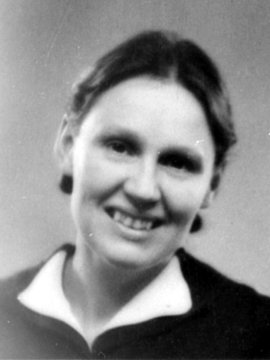
Dorothee Poelchau
June 06, 1902 – November 04, 1977
Dorothee Ziegele was born in Steinkirchen in 1902, the second daughter of the pastor Paul Eugen Ziegele and his wife Berta. She was influenced by the youth movement. In the winter semester of 1921/22, she began studying German literature in Leipzig. In parallel, she trained at the Leipzig librarian school, where she qualified for the mid-level library service in 1923. She obtained a post at Tübingen university library that year. While working there, Dorothee Ziegele met Harald Poelchau. In 1926 she took a post in the library of the Reich Statistics Office in Berlin. Dorothee and Harald Poelchau married in Herrenberg/Württemberg on April 12, 1928. Both of them were against the Nazi regime from the very beginning. Their son Harald Stephan junior was born in 1938. Dorothee Polechau was actively involved in her husband’s covert aid for Jews in hiding and the relatives of political prisoners. She obtained food and looked after people, whom the couple took into their own home. She also made various contacts on behalf of those in need of accommodation. She prepared meals, which her husband managed to send to inmates in the various prisons. In the last weeks of the war she left Berlin with her son Harald, but returned to the city in the summer of 1945.
The German Resistance Memorial Center – www.gdw-berlin.de/en/home/
Photo: Private
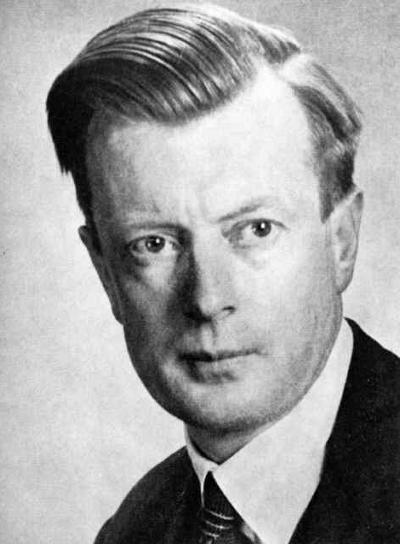
Harald Poelchau
October 05, 1903 – April 29, 1972
Born in Potsdam as the son of a pastor, Harald Poelchau grew up in Silesia. He began studying theology at the Church University in Bethel in 1922, followed by social work at the Berlin College of Political Science. After working for two years as managing director of the German Union for Juvenile Courts and Legal Aid for Juveniles, he gained his doctorate in 1931 under Paul Tillich, the leading representative of Religious Socialism. At the end of 1932, Poelchau applied for a prison chaplain’s post in Berlin and became the first cleric to be employed by the National Socialist regime in a penal institution. As an official in the Justice Department he rapidly became an important source of support for the victims of National Socialist violence, and gave spiritual comfort to hundreds of people sentenced to death as they faced execution. From 1941 on he was a member of the circle around Helmuth James Graf von Moltke and attended the first major Kreisau Conference. After the unsuccessful coup attempt of July 20, 1944 he was able to pass on last messages and farewell letters to the relatives of many of those sentenced for involvement in the coup attempt. Harald Poelchau managed to avoid being investigated by the Gestapo and survived the war.
The German Resistance Memorial Center – www.gdw-berlin.de/en/home/
Photo: Institut für Zeitgeschichte, München, Signatur: ED 106/39

Johannes Popitz
December 02, 1884 – February 02, 1945
Johannes Popitz, an administrative lawyer, had served in the Reich Ministry of Finance since 1919, where he was appointed state secretary in 1925. He was married to Cornelia Slot, with whom he had a daughter and two sons. Chancellor Franz von Papen appointed him Reich commissar for the Prussian Ministry of Finance after deposing the government of Prussia on July 20, 1932. A year later on April 21, 1933, the National Socialist leaders appointed Popitz as the new Prussian minister of finance. From 1938 on, he worked together with Hans Oster from the Office for Foreign Affairs/Counter Intelligence. He established numerous contacts with military opposition circles. Popitz personified the inherent contradictions in resistance motivated by conservative convictions: He held high government offices but nonetheless drifted into the circle of opposition to the regime. In the end, he supported the coup attempt. He was a member of the Mittwochsgesellschaft. In 1939-40, he drafted an arch-conservative “Provisional Basic Law of the State.” In a meeting with Heinrich Himmler, he attempted to ascertain how the SS felt about attempting a coup. Popitz remained a controversial figure in the eyes of many conspirators, although he was designated to become minister of education and cultural affairs in the event the coup should succeed. After the failure of the assassination attempt of July 20, 1944, the Gestapo arrested Popitz despite his contacts with Heinrich Himmler. Johannes Popitz was sentenced to death by the People’s Court on October 3, 1944, and murdered five months later in Berlin-Plötzensee.
The German Resistance Memorial Center – www.gdw-berlin.de/en/home/
Photo: Gedenkstätte Deutscher Widerstand

Adolf Reichwein
October 03, 1898 – October 20, 1944
Adolf Reichwein, an educator and close associate of Prussian minister of education and cultural affairs Carl Heinrich Becker, spoke out in support of a program of community colleges, adult education programs, and continuing education for teachers after the First World War. In 1930, Reichwein became a professor of history and political science at the newly opened Academy of Education in Halle. There he was dismissed for political reasons on April 24, 1933. He was married to Rosemarie Pallat, with whom he had three daughters and a son. Reichwein spent the following years as a country schoolteacher in Tiefensee near Berlin, later as an educator at the State Museum of German Folklore in Berlin. From 1940 on, he was in contact with the resistance circles around Wilhelm Leuschner and Julius Leber and was himself a member of the Kreisau Circle. In the summer of 1944, he met with the Communist leaders Anton Saefkow and Franz Jacob. These contacts led to his arrest in early July 1944. Adolf Reichwein was sentenced to death by the People’s Court on October 20, 1944, and murdered the same day in Berlin-Plötzensee.
The German Resistance Memorial Center – www.gdw-berlin.de/en/home/
Photo: Adolf-Reichwein-Archiv, Münster

Ernst Schneppenhorst
April 19, 1881 – April 24, 1945
Ernst Schneppenhorst learned the trade of joiner and was managing director of the German Woodworkers’ Federation in Nuremberg from 1906 to 1918. He was also a member of the Bavarian State Parliament for the Social Democratic Party (SPD) from 1912 to 1920, and a member of the Reichstag from 1932-33. After the National Socialists took power he lost his optician’s business and was held in custody for a year in 1937. Afterwards he re-established contact with Wilhelm Leuschner. In the fall of 1943 and the spring of 1944, Schneppenhorst arranged contacts for Leuschner to former labor unionists. Following the unsuccessful assassination attempt on July 20, 1944, these connections were discovered and Ernst Schneppenhorst was arrested. He was imprisoned in Sachsenhausen concentration camp and later in Lehrter Straße Prison in Berlin. In the early morning of April 24, 1945, Ernst Schneppenhorst and his fellow-prisoners, Albrecht Graf Bernstorff and Karl Ludwig Freiherr von und zu Guttenberg, were taken together from their cells and murdered by an SS commando.
The German Resistance Memorial Center – www.gdw-berlin.de/en/home/
Photo: Landesarchiv Nordrhein-Westfalen, Abteilung Rheinland, Signatur: RW 58/3736, fol. 89

Kurt Schumacher
October 13, 1895 – August 20, 1952
Kurt Schumacher studied law and politics from 1915 to 1919 and obtained his doctorate in 1920. He joined the SPD as a student in 1918. As politics editor for the Schwäbische Tagwacht in Stuttgart from 1920 to 1930, he became a prominent representative of the city’s Social Democracy. He was a passionate supporter of the threatened Weimar Republic and opponent of anti-democratic forces. He was chairman of the Stuttgart local organization of the Reich Banner Black-Red-Gold for several years. Kurt Schumacher became a member of the Reichstag in September of 1930. When Joseph Goebbels called the SPD a “party of deserters” in the Reichstag on February 23, 1932, he responded with a spontaneous speech honored as one of the sharpest attacks on National Socialism to this day. Placed on wanted lists, Schumacher was arrested in Berlin on July 6, 1933. Following brief spells in prisons in Berlin and Stuttgart, he was then sent between various concentration camps for almost ten years. On his release from Dachau concentration camp, he was forced to stay in Hannover. He was imprisoned again for several weeks after the attempted coup of July 20, 1944, this time in Neuengamme concentration camp, near Hamburg. From Hannover, the undisputed leading figure of Social Democracy began rebuilding the SPD. In 1946 the SPD party congress voted him party chairman. He retained this office until his death in 1952.
The German Resistance Memorial Center – www.gdw-berlin.de/en/home/
Photo: AdSD / Friedrich-Ebert-Stiftung, Signatur: 6/FOTA046603

Ludwig Schwamb
July 30, 1890 – January 23, 1945
After studying law and practising for a while as an attorney, Ludwig Schwamb began a career in administration in 1925. As a social democrat, in 1928 he was appointed with Carlo Mierendorff as a personal consultant in the Interior Ministry in Hesse under Wilhelm Leuschner. After the National Socialists took power in 1933, Schwamb lost his post. He moved to Berlin and worked as a corporation lawyer in a shoe factory. In the following years he maintained close contact with his social democratic friends Leuschner, Mierendorff, and Leber, who were gradually released from concentration camps. The conspirators of July 20, 1944 proposed Schwamb as political commissioner for military district XII (Wiesbaden). After the unsuccessful coup attempt on July 20, 1944, he was arrested with his wife on July 23, 1944 in Frankfurt am Main. His wife was released a few days later. After months in custody in Lehrter Straße Prison, Ludwig Schwamb was sentenced to death by the People’s Court under Roland Freisler on January 13, 1945. Ludwig Schwamb was murdered on January 23, 1945 in Berlin-Plötzensee.
The German Resistance Memorial Center – www.gdw-berlin.de/en/home/
Photo: Institut für Zeitgeschichte, München, Signatur: ED 106/57
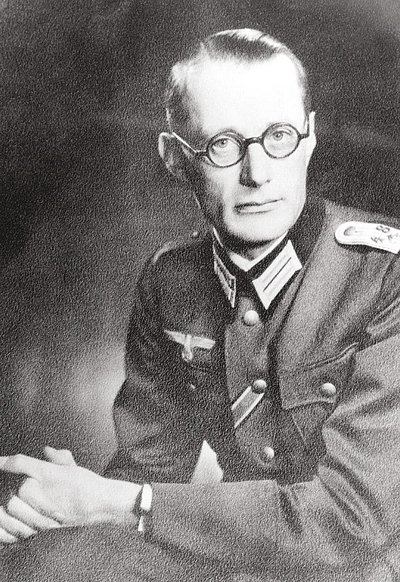
Ulrich-Wilhelm Graf von Schwerin von Schwanenfeld
December 21, 1902 – September 08, 1944
The agriculturalist Ulrich-Wilhelm Graf von Schwerin von Schwanenfeld was born in Copenhagen. He studied agriculture in Munich, Berlin, and Breslau. He witnessed the “Hitler putsch” in Munich in 1923, prompting him to reject National Socialism. He married Marianne Sahm in 1928, and the couple later had five sons. His active resistance activities began in 1938, in close collaboration with his friends Peter Graf Yorck von Wartenburg and Fritz-Dietlof Graf von der Schulenburg. He became an important link between the civilian and military opposition during the 1938 “Sudetenland crisis” due to his contacts to the Foreign Office and the Office for Foreign Affairs/Counterintelligence in the Armed Forces High Command. Called up as a reserve officer on the outbreak of war, he worked on the staff and in the direct personal vicinity of the later Field Marshal and Commander in Chief West Erwin von Witzleben from November 1939 on. He heard of mass shootings of Polish Christians and Jews in the gravel pit on his Polish estate of Sartowitz as early as 1939. After Witzleben’s transfer, he was posted from Paris to Utrecht in 1942 as “politically unreliable.” In March 1943, Hans Oster had him transferred to Berlin, where he was involved in the preparations for the coup in various ways. He was associated with the Kreisau Circle via his friend Yorck, advocating a political renewal of Germany on the basis of Christian and social principles like his friend. In Berlin, he made friends with Claus Schenk Graf von Stauffenberg in September 1943. Planned as the undersecretary of state to the designated head of state Ludwig Beck, he remained in the innermost circle of conspirators until the very end. On July 20, 1944, he waited for news of the assassination in the “Wolf’s Lair” in his office, along with Berthold Schenk Graf von Stauffenberg, Yorck, and Schulenburg. He was arrested in the Bendler Block late that evening, sentenced to death by the People’s Court on August 21, and murdered in Berlin-Plötzensee on September 8, 1944.
The German Resistance Memorial Center – www.gdw-berlin.de/en/home/
Photo: Private
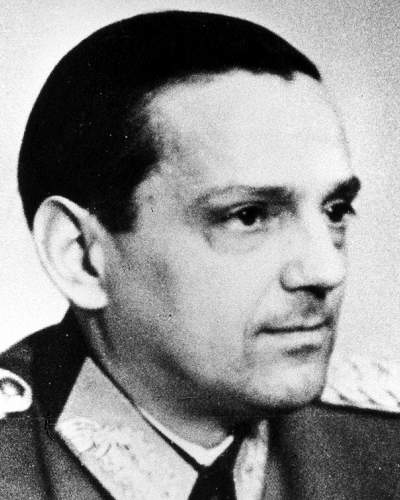
Hellmuth Stieff
June 06, 1901 – August 08, 1944
Hellmuth Stieff completed an officer training course after the First World War and was transferred to the general staff in 1938. From October 1942 on he was chief of the Organization Department in the Army High Command. After discussions with Henning von Tresckow, in the summer of 1943 Stieff decided to collaborate in the preparations to kill Hitler. He tried to persuade General Field Marshal Günther von Kluge to take part in the coup attempt. In the following months, Stieff safeguarded explosives for an assassination attempt on Hitler on several occasions. However, he refused to carry out the assassination himself. He was arrested in East Prussia on the night of July 20, 1944 and severely maltreated by the Gestapo during interrogation. Hellmuth Stieff was sentenced to death by the People’s Court on August 8, 1944 and murdered the same day in Berlin-Plötzensee.
The German Resistance Memorial Center – www.gdw-berlin.de/en/home/
Photo: Bundesarchiv/Militärarchiv, Signatur: Bild 146-1981-072-71
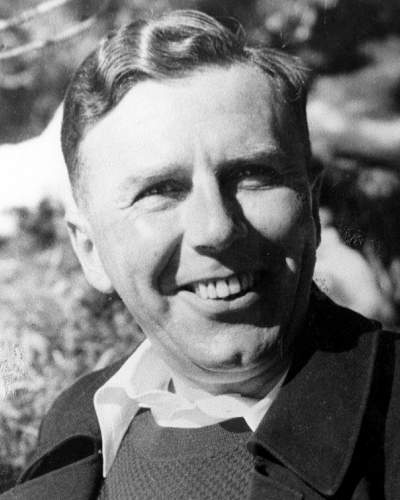
Theodor Struenck
05. April 1895 – 09. April 1945
After graduating in law, Theodor Strünck took up a leading position in the insurance business. In the early 1920s he was more attracted to nationalist forces than to the parties of the Weimar Republic. However, the blatant violations of the law after the National Socialists took power lead him to sympathize with opposition circles. In 1937, at the instigation of Hans Oster, Strünck was enlisted as a reserve officer for service in the Office for Foreign Affairs/Counterintelligence in the Armed Forces High Command. He was already involved in plans for a coup in 1938, and collaborated closely with Hans Oster and Carl Goerdeler to support the efforts to overthrow Hitler. After the unsuccessful assassination attempt of July 20, 1944, Strünck did not use his chances to flee to Switzerland because he wanted to spare his relatives the ordeal of “Sippenhaft” (imprisonment for families held responsible for the political crimes of a family member). He was arrested with his wife Elisabeth on August 1, 1944. Theodor Strünck was sentenced to death by the People’s Court on October 10, 1944 and imprisoned in Flossenbürg concentration camp, where he was murdered on April 9, 1945.
The German Resistance Memorial Center – www.gdw-berlin.de/en/home/
Photo: Institut für Zeitgeschichte, München, Signatur: NL Hammer, ED 106, Bd. 58

Richard Teichgräber
August 05, 1884 – Februar 25, 1945
Born in the Saxon town of Dahlen, east of Leipzig, Richard Teichgräber grew up in a working-class family. Following his apprenticeship as a metalworker, he became increasingly involved in the trade union Deutscher Metallarbeiterverband (DMV) and began a career there: from 1918, he was a full-time trade union official, and went on to become district leader for Saxony. At the same time, he was active politically and served as city councillor in Leipzig from 1919 to 1925, representing the Social Democrats, the SPD/USPD.
On May 2, 1933, just a few weeks after the seizure of power by the National Socialists, the free trade unions were broken up and their members persecuted. A network emerged, aimed at establishing contact with the international trade union movement. This network also included Teichgräber. Through contacts abroad, information gathered in German firms was relayed to Social Democratic exile organisations. Exile newspapers such as the “Neuer Vorwärts” (New Forwards) and other publications were distributed in an attempt to circumvent censorship in Germany and counter National Socialist propaganda.
Teichgräber increasingly put himself in danger through his trade union activities: on December 15, 1934, he was arrested by the Gestapo and taken to Sachsenburg Concentration Camp near Chemnitz in 1935. He was released several months later but arrested again shortly afterwards and given a lengthy prison sentence by the Volksgerichtshof (People’s Court) in 1937 for “making preparations for high treason”. In 1938, he was deported from prison to a series of concentration camps, first to Buchenwald, then in January 1944 to Majdanek, and following its evacuation, to Auschwitz. Not long before the end of the war, he and other prisoners were transported to Mauthausen Concentration Camp in Austria. He was murdered in the sub-camp at Melk on February 25, 1945 (presumably).
Berliner Forum für Geschichte und Gegenwart e.V.
Photo: Saxon State and University Library Dresden
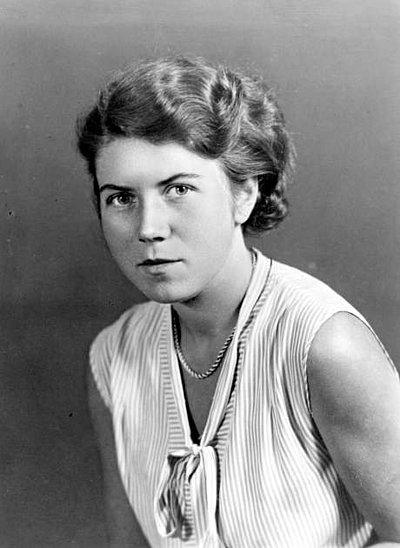
Maria Terwiel
June 07, 1910 – August 05, 1943
Maria Terwiel was born on June 7, 1910 in Boppard am Rhein. She attended high school in Stettin, where her father worked as deputy commissioner in the office of the regional commissioner of the province of Pomerania. After obtaining her school-leaving certificate in 1931, Maria Terwiel studied law in Freiburg and Munich. In Freiburg she met her future fiancé, Helmut Himpel. Since she was “half-Jewish”, she had no prospect of the trainee civil service post required for a law qualification. She broke off her studies and returned to her family, who had moved to Berlin. She earned her living as a secretary in a French-Swiss textile firm. Maria Terwiel and Helmut Himpel supported Jewish people by obtaining food ration cards and identity papers for them. The couple met Harro Schulze-Boysen and John Graudenz and took part in the actions of the resistance group around Schulze-Boysen. Maria Terwiel duplicated several leaflets on her typewriter, including the “AGIS” leaflet, “The People are Troubled about Germany’s Future!” in January 1942. She also participated with Fritz Thiel in the flyposting action on August 17-18, 1942 against the National Socialist propaganda exhibition “The Soviet Paradise”. At the beginning of September 1942, Fritz Thiel handed over a radio transmitter to her. Maria Terwiel was arrested on September 17, 1942, sentenced to death by the Reich Court Martial on January 26, 1943 and murdered in Berlin-Plötzensee on August 5, 1943.
The German Resistance Memorial Center – www.gdw-berlin.de/en/home/
Photo: Private

Adam von Trott zu Solz
August 09, 1909 – August 26, 1944
Born in Potsdam as the fifth child of the Prussian minister of culture August von Trott zu Solz, Adam von Trott zu Solz grew up in an atmosphere of liberal open-mindedness in Berlin, Kassel and on the family estate of Imshausen in Hesse. He studied law in Munich, Berlin and Göttingen from 1927 on. After receiving his doctorate he went up to Oxford on a Rhodes scholarship, making many friends in England. He studied ”PPE“ (politics, philosophy, economics) before returning to Germany in 1933 to continue his training as a lawyer. He took his civil service examination in 1936. At around this time, he was in contact with underground socialists. In 1937/38 he spent a year in China as a Rhodes scholar. His many periods abroad made a strong impression on him. On his return to Germany he made contact to other opponents of the regime, including Helmuth James Graf von Moltke and Hans von Dohnanyi, and attempted to persuade the British government to support them in 1939. After the outbreak of war, he made appeals on behalf of the German resistance in the USA. He joined the Foreign Office information department in 1940 and later become head of the India department, promoted to Second Secretary in 1943. From 1942 to 1944 he made frequent trips to Switzerland and Sweden and sought contacts to the Allies for foreign support for the planned coup. As a central member of the Kreisau Circle, he chaired the discussion on the foundations of Germany’s future foreign policy at the third Kreisau conference over Pentecost of 1943. From the fall of 1943 on, he worked in close cooperation with Claus Schenk Graf von Stauffenberg and Julius Leber. He was arrested five days after the failed assassination attempt of July 20, 1944, sentenced to death by the People’s Court on August 15, and murdered in Berlin-Plötzensee on August 26, 1944.
The German Resistance Memorial Center – www.gdw-berlin.de/en/home/
Photo: Private

Oswald Wiersich
September 01, 1882 – March 01, 1945
Oswald Wiersich was still serving his apprenticeship in mechanical engineering when he joined the labor movement. He became an employee of his professional organization and was a representative of the German Metalworkers’ Federation in Breslau from 1912 on. In 1923 he became district secretary of the General Federation of German Labor Unions (ADGB) in Silesia. In the 1920s he was a member of the Prussian State Parliament for the Social Democratic Party (SPD). After the National Socialists took power, in March 1933 Wiersich and other labor unionists and social democrats were taken into “Schutzhaft” (“protective custody”) for several weeks. In the following year Wiersich found work as a book-keeper and tried to consolidate the links between Silesian labor union circles. His close contact to Wilhelm Leuschner gave him the opportunity to meet Ludwig Beck early on. After the unsuccessful assassination attempt of July 20, 1944, Wiersich was arrested on August 22, 1944 because of his contacts to Michael Graf von Matuschka, Fritz-Dietlof Graf von der Schulenburg and the labor unionist Fritz Voigt. Oswald Wiersich was sentenced to death by the People’s Court on February 28, 1945 and murdered in Berlin-Plötzensee on March 1, 1945.
The German Resistance Memorial Center – www.gdw-berlin.de/en/home/
Photo: Institut für Zeitgeschichte, München, Signatur: Ed. 106 Bd. 60

Josef Wirmer
March 19, 1901 – September 08, 1944
Josef Wirmer opened a law office in Berlin after studying law. He established contacts with politicians of the Weimar coalition parties that governed Prussia until 1932. An active Catholic, Wirmer joined the Center Party early and strengthened the party’s uncompromisingly democratic left wing. He was married to Hedwig Preckel, with whom he had two daughters and a son. After Hitler’s rise to power, he became an outspoken critic of the leaders of the party’s parliamentary faction, who approved the Enabling Act and later even approved a resolution for the Center Party to dissolve itself. As an attorney, Wirmer assisted victims of racial and political persecution. From 1936 on, he worked together with opposition labor leaders such as Jakob Kaiser, Wilhelm Leuschner, and Max Habermann and established contact to former members of the Center Party in Cologne and Düsseldorf. From 1938 on, he was a close confidant of Hans Oster and Hans von Dohnanyi. In 1941-42, he joined the circle around Carl Goerdeler, who planned to make him minister of justice in his post-coup cabinet. After the failure of the assassination attempt of July 20, 1944, Wirmer was arrested on August 4 and held in the Ravensbrück concentration camp. Before the People’s Court, he sought an open confrontation with Freisler. Wirmer was sentenced to death on September 8, 1944, and murdered the same day in Berlin-Plötzensee.
The German Resistance Memorial Center – www.gdw-berlin.de/en/home/
Photo: Bundesarchiv, Signatur: NL Kaiser

Erwin von Witzleben
December 04, 1881 – August 08, 1944
A career officer, Erwin von Witzleben was among those allowed to remain in service in the Reichswehr after the First World War. He was married to Else Kleeberg, with whom he had a daughter and a son. Commander of military district III (Berlin) from 1934 on, Witzleben advocated the violent overthrow of Hitler as early as 1938. From this time on, he remained in close contact with Ludwig Beck, Hans Oster, Paul von Hase, and Carl Goerdeler. In 1939 and 1940, Witzleben served in the Polish and French campaigns. Hitler promoted him to field marshal on July 19, 1940. He appointed Witzleben commander in chief of Army Group D in France that same year and Commander in Chief West in 1941. In 1942, he was replaced and transferred to the “Führer’s reserve.” From that time on, he maintained close contacts with the resistance organizations in Berlin and also with Henning von Tresckow in Army Group Center. After the attempt on Hitler’s life on July 20, 1944, Witzleben assumed command of the armed forces. He was arrested immediately after the failure of the coup on July 21, 1944. On August 8, 1944, he was sentenced to death by the People’s Court and murdered several hours later in Berlin-Plötzensee.
The German Resistance Memorial Center – www.gdw-berlin.de/en/home/
Photo: Gedenkstätte Deutscher Widerstand

Emmy Zehden
March 28, 1900 – June 09, 1944
Emmy Windhorst was born in Lübbecke in 1900 and worked as a domestic servant after leaving school. She lived in Berlin from 1918 on, and in the mid-1920s married Richard Zehden, who later suffered discrimination under the Nuremberg race laws. In 1930 she joined the Bible Students (Jehovah’s Witnesses). Her husband was sentenced to almost a year’s imprisonment in 1938 for belonging to this religious community. Like all Bible Students, Emmy Zehden was a determined opponent of military service, and influenced her nephew to go into hiding to avoid being drafted. Although her husband was in prison and Emmy Zehden knew that her views might have dangerous consequences, she stuck to her convictions. She was sentenced to death for hiding her nephew and two other Bible Students evading the draft. Following rejected pleas for clemency, Emmy Zehden was murdered in Berlin-Plötzensee on June 9, 1944. Her farewell letters were never given to her family.
The German Resistance Memorial Center – www.gdw-berlin.de/en/home/
Photo: Gedenkstätte Deutscher Widerstand







